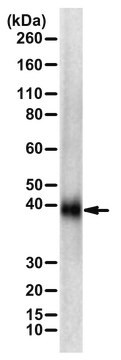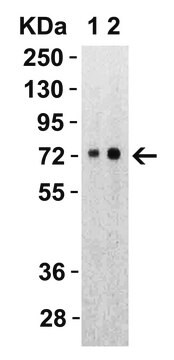MABF2815
Anti-SARS-CoV-2 Spike RBD Antibody, clone 6C2-G9
About This Item
Productos recomendados
origen biológico
mouse
Nivel de calidad
conjugado
unconjugated
forma del anticuerpo
purified antibody
tipo de anticuerpo
primary antibodies
clon
6C2-G9, monoclonal
mol peso
calculated mol wt 141.18 kDa
observed mol wt ~200 kDa
reactividad de especies
virus
envase
antibody small pack of 100 μg
técnicas
ELISA: suitable
immunoprecipitation (IP): suitable
neutralization: suitable
western blot: suitable
isotipo
IgG1
Nº de acceso UniProt
Condiciones de envío
dry ice
temp. de almacenamiento
-10 to -25°C
modificación del objetivo postraduccional
unmodified
Descripción general
Especificidad
Inmunógeno
Aplicación
Evaluated by Western Blotting in lysate from HEK293T cells expressing full-length spike protein of SARS-CoV-2 virus.
Western Blotting Analysis (WB): A 1:1,000 dilution of this antibody detected Spike glycoprotein in HEK293T cells expressing full-length spike protein of SARS-CoV-2, but not in lysate from wild-type HEK293T cells.
Tested Applications
Neutralizing: A representative lot neutralized SARS-CoV-2 Spike protein RBD to ACE2 in Neutralizing applications (Courtesy of Kento Abe and Anne-Claude Gingras, Toronto).
ELISA Analysis: A 1:3 dilution from a representative lot detected SARS-CoV-2 Spike protein. (Courtesy of Stefan Schüchner, Ingrid Mudrak, Ingrid Frohner, and Egon Ogris (Max Perutz Labs, Medical University of Vienna, Austria).
Western Blotting Analysis: A 1:400 dilution from a representative lot detected Sars-CoV-2 Spike protein in Whole cell lysates of HEK293T cells expressing full-length spike protein of SARS-CoV-2. (Courtesy of Stefan Schüchner, Ingrid Mudrak, Ingrid Frohner, and Egon Ogris (Max Perutz Labs, Medical University of Vienna, Austria).
Neutralizing: A representative lot neutralized SARS-CoV-2 Spike protein RBD binding to ACE2 receptor. (Abe, K.T., et al. (2020). JCI Insight 5(19):e142362).
Immunoprecipitation Analysis: A representative lot immunoprecipitated SARS-CoV-2 Spike protein. (Courtesy of Stefan Schüchner, Ingrid Mudrak, Ingrid Frohner, and Egon Ogris (Max Perutz Labs, Medical University of Vienna, Austria).
Note: Actual optimal working dilutions must be determined by end user as specimens, and experimental conditions may vary with the end user
Forma física
Almacenamiento y estabilidad
Otras notas
Cláusula de descargo de responsabilidad
Not finding the right product?
Try our Herramienta de selección de productos.
Código de clase de almacenamiento
12 - Non Combustible Liquids
Clase de riesgo para el agua (WGK)
WGK 2
Punto de inflamabilidad (°F)
Not applicable
Punto de inflamabilidad (°C)
Not applicable
Certificados de análisis (COA)
Busque Certificados de análisis (COA) introduciendo el número de lote del producto. Los números de lote se encuentran en la etiqueta del producto después de las palabras «Lot» o «Batch»
¿Ya tiene este producto?
Encuentre la documentación para los productos que ha comprado recientemente en la Biblioteca de documentos.
Nuestro equipo de científicos tiene experiencia en todas las áreas de investigación: Ciencias de la vida, Ciencia de los materiales, Síntesis química, Cromatografía, Analítica y muchas otras.
Póngase en contacto con el Servicio técnico





